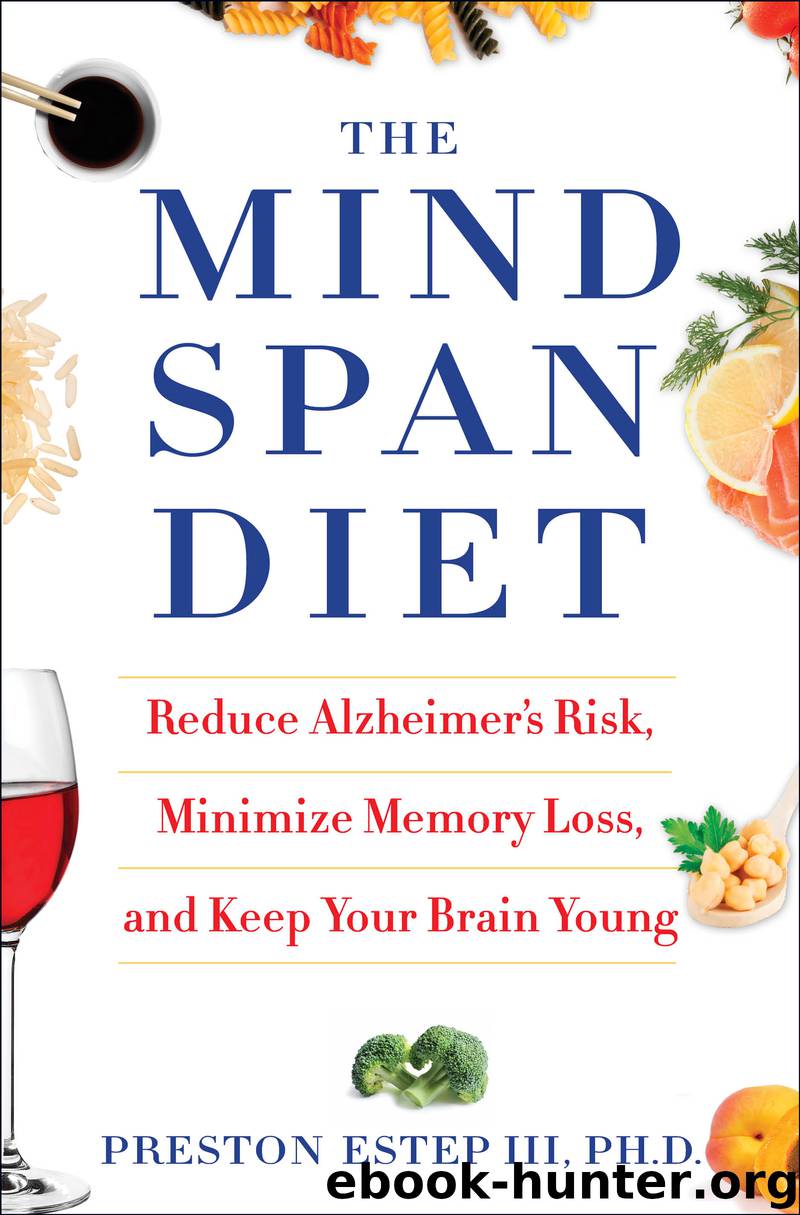The Mindspan Diet by Preston Estep III

Author:Preston Estep, III
Language: eng
Format: epub
Publisher: Random House Publishing Group
Published: 2016-05-02T16:00:00+00:00
* * *
*1The impressive protection against heart disease offered by certain variants of the gene PCSK9 (through reduction of LDL cholesterol) shows that this is one way in which red meat increases cardiovascular diseases.
*2Data primarily from the Food and Agriculture Organization (FAO) of the United Nations, representing a fifty-year average, from 1961 to 2011.
9.
X Factors—The Last Piece of the Puzzle
Most diets and food pyramids focus only on carbs, fats, and protein, claiming they are the only sources of food energy. Some diet gurus insist that fat is responsible for obesity, but more recently we’ve heard from many more that weight gain is all about carbs. Some expert scientists counter that only total food energy matters (an oft-heard mantra from this group is “A calorie is a calorie is a calorie”). Now we know one thing for certain: All of these claims are wrong. Why? Many reasons; but to start with, they ignore the role of other crucial players in the diet, especially X factors.
We touched briefly on X factors back in chapter 2: these mysterious agents are the products of fermentation, the process by which microbes metabolize food and release energy. In ancient times fermentation was regarded as a divine or mystical process. It changed foods into tangy, pungent, and fizzy concoctions that tingled the tongue and even altered perceptions. (The roots of the word “ale,” a common fermented beverage of ancient times, mean sorcery, magic, and intoxication.) The tingle, the tang, and the tipsy are X factors at work.
First and foremost, X factors are fuel for your body, just like carbs, fats, and protein, but they have some unique and powerful properties not shared by these other macronutrients. There are two reasons I call them X factors. One is that they typically don’t appear on diet pyramids or expert lists of calorie sources. The other is that many fermented foods contain a wide array of such factors (some foods contain over a hundred), their amounts are variable, and the identities and amounts of each in any given dish or bite of food are simply unknown. Here are some of the best-known and most abundant X factors.
•Short-chain fatty acids (SCFAs): Some key SCFAs in our diets are lactic, butyric, acetic, and propionic. Lactic acid is responsible for the tartness of yogurt, sour cream, sourdough bread, buttermilk, and many cheeses. Butyric acid gives old butter a distinctive aroma and flavor, and dilute acetic acid is vinegar.
•Alcohol: A main source of X factor calories is alcohol, also known as ethanol. At about 7 calories per gram, the caloric content of ethanol is between carbs and protein (both have about 4 calories per gram) and fat (about 9 calories per gram).
A normal diet will provide a substantial amount of your daily fuel energy as X factors. But X factors do more than just provide fuel: even small amounts cause pronounced physiological changes in your body. Just a couple of teaspoons of vinegar or a slice of sourdough bread will slow overall digestion and absorption of sugar into the bloodstream—blunting potential blood sugar spikes.
Download
This site does not store any files on its server. We only index and link to content provided by other sites. Please contact the content providers to delete copyright contents if any and email us, we'll remove relevant links or contents immediately.
| Beauty, Grooming & Style | Diets & Nutrition |
| Exercise | Longevity |
| Medical Conditions & Diseases |
The Longevity Diet by Valter Longo(5019)
The Body: A Guide for Occupants by Bill Bryson(4974)
Ikigai by Héctor García & Francesc Miralles(4125)
Limitless by Jim Kwik(3086)
The Checklist Manifesto by Atul Gawande(2776)
The Body by Bill Bryson(2567)
Memory Rescue by Daniel G. Amen(2376)
What Color Is Your Parachute? 2015 by Richard N. Bolles(2261)
Breath by James Nestor;(2227)
Becoming Myself by Irvin D. Yalom(2225)
Fat for Fuel by Joseph Mercola(1971)
Memory Rescue: Supercharge Your Brain, Reverse Memory Loss, and Remember What Matters Most by Amen Dr. Daniel G(1947)
Awakening Your Ikigai by Ken Mogi(1768)
Weight Training by Thomas Baechle(1738)
50 After 50 by Maria Leonard Olsen(1680)
Starting Over (Sugar Creek Romance ) by Jordan Silver(1651)
1610396766 (N) by Jo Ann Jenkins(1625)
The Telomerase Revolution by Michael Fossel(1624)
Dirt by Bill Buford(1610)
